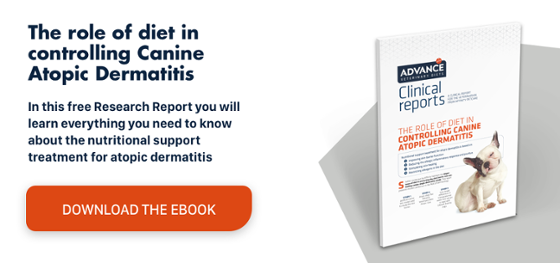Canine atopic dermatitis and the use of cyclosporine
Canine atopic dermatitis: introduction
1. Hypersensitivity to environmental allergens: atopic animals initially present a humoural immune response to percutaneous or mucosal contact with allergens, resulting in the production of allergen-specific IgEs. This reaction has been defined as a T-helper-2-type response, in which specific T lymphocytes produce IL-4, IL-5 and IL-13 and stimulate the biosynthesis of allergen-specific IgEs. These IgEs bind to the surface of skin mast cells via specific receptors and further contact with the allergens induces mast cell degranulation and the release of mediators, such as histamine, prostaglandins or leukotrienes. In this model, secondary infections (either bacterial or due to Malassezia) and scratching play a key role in perpetuating an active inflammatory response.
2. Alterations to the skin barrier: the epidermis constitutes an effective barrier whereby keratinocytes are sealed by intercellular bridges (desmosomes) and an extracellular protein- and lipid-based cement. Changes to the protective function of the epidermis, whether genetic or acquired, would allow greater allergen penetration, leading to an abnormal immune response, in other words, hypersensitivity. Skin barrier dysfunction results in an increase in percutaneous penetration of allergens and transepidermal water loss (TEWL), which is probably responsible for the characteristic dryness associated with atopic dermatitis.
Download the free clinical study on the role of diet in the control of canine atopic dermatitis
For access to more interactive content on veterinary dermatology, click here
CAD is diagnosed clinically. It is established in dogs with a compatible clinical history and signs after ruling out other common causes of pruritus, such as sarcoptic mange, demodicosis, bacterial folliculitis, Malassezia dermatitis and food allergies.
Canine atopic dermatitis: treatment
There are various therapeutic measures and lifestyle changes that significantly improve the animal’s clinical signs.
General support measures are treatments that are not enough by themselves to control the most severe cases of CAD, but nevertheless facilitate its management and permit the use of lower drug doses:
- Strict control of ectoparasites
- Frequent baths with an appropriate shampoo
- Feeding with a specific feed: advance veterinary diet atopic care which acts at three levels
- Aloe vera gel and omega-6 fatty acids work by increasing the lipid layer of the epidermis.
- Marked anti-inflammatory activity.
- Helps the healing and repair process.
There are currently three main therapeutic approaches to CAD: allergen-specific immunotherapy, corticosteroid therapy (topical or systemic) and cyclosporin A.
Specifically, cyclosporin A (5 mg/kg/day, initial dose) is known to be an effective treatment for CAD with studies reporting positive outcomes in over 80% of cases. It provides immunosuppressive activity by binding to a protein for immunocompetent lymphocytes, more specifically T lymphocytes.
Its broad safety margin in dogs, together with the limited interindividual variability and absence of any correlation between blood concentrations and clinical response eradicate the need for routine monitoring of cyclosporine A blood levels in dogs with atopic dermatitis.
The occasional appearance of side effects (vomiting, gingival hyperplasia, diarrhoea, etc.) is the main limitation of cyclosporine.
Regarding maintenance treatment with cyclosporine A, studies show that canine atopic dermatitis can be controlled via two methods, namely dose reduction or longer administration intervals.


